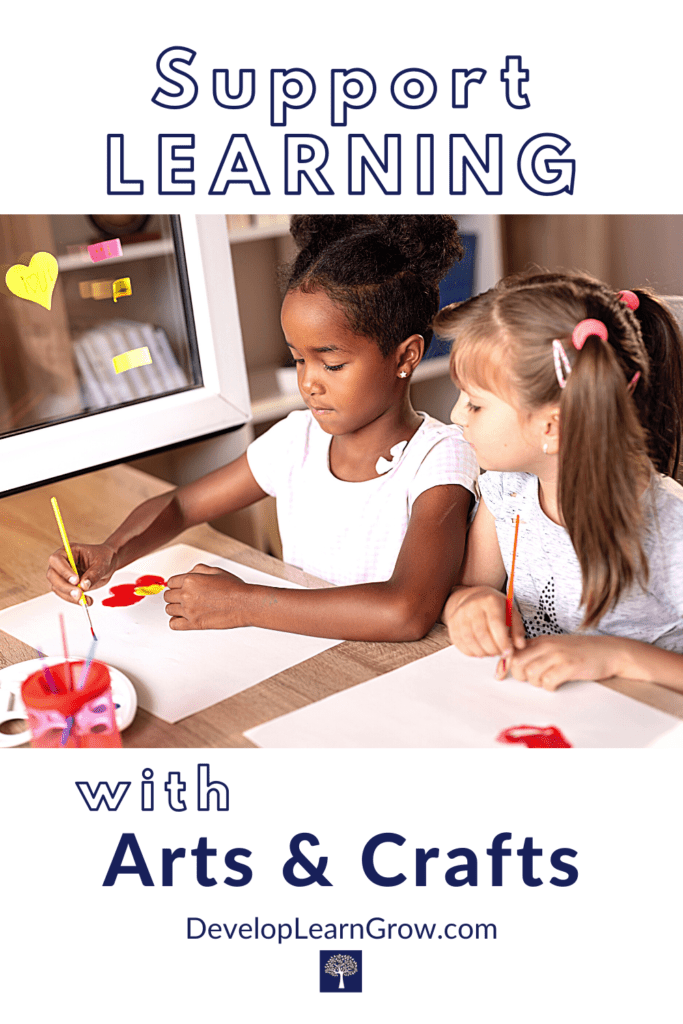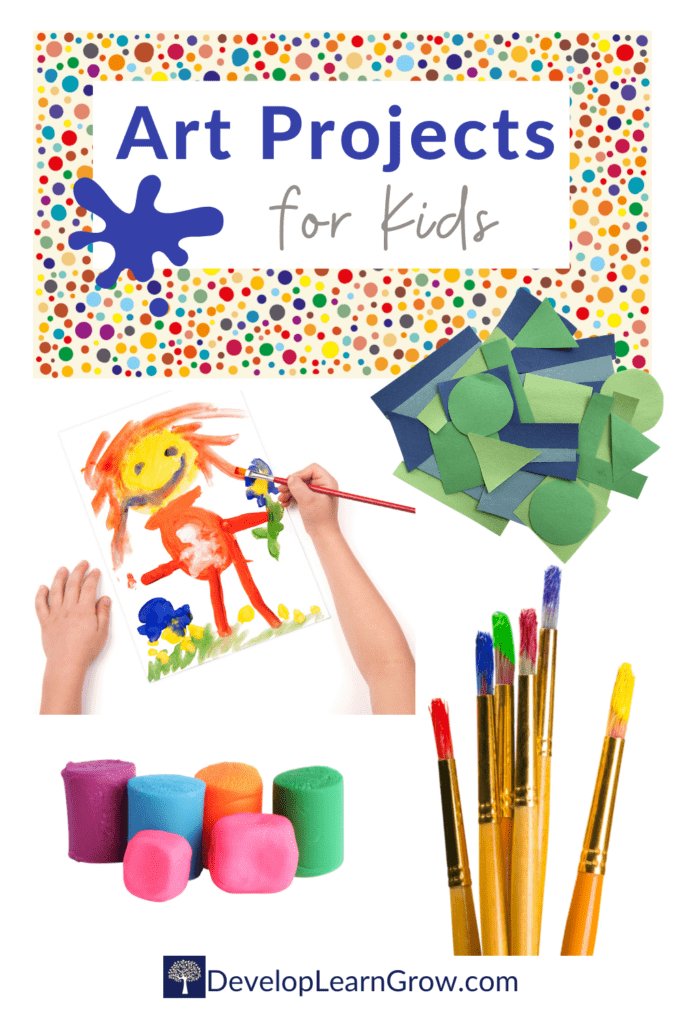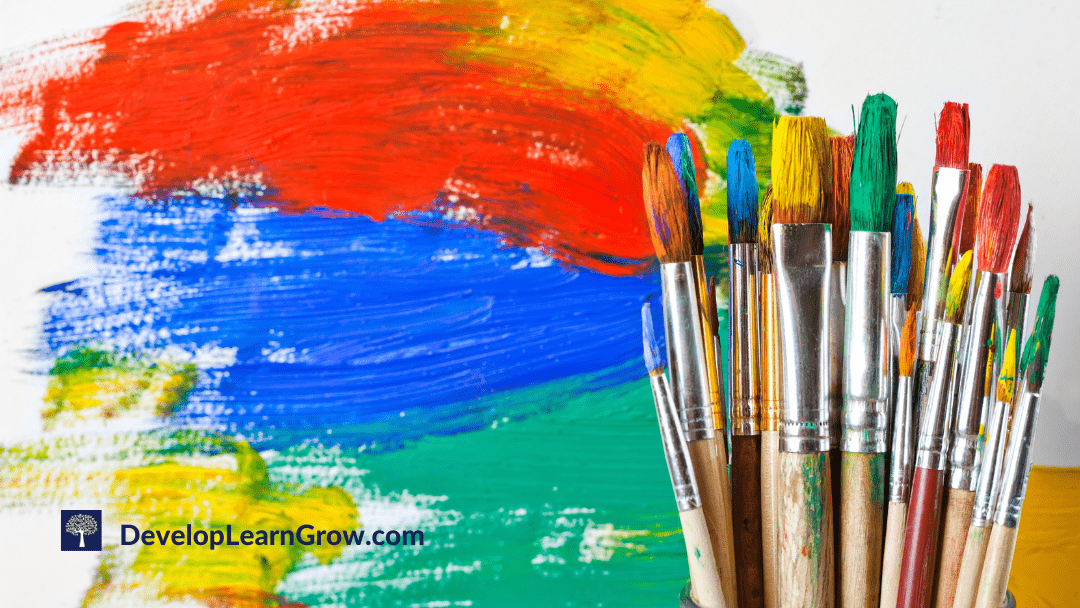Art projects for kids in elementary school are a great way to support development and learning. Project based learning activities are a fun way to strengthen skills needed for READING, WRITING and MATH.
Art projects and craft activities for kids are not just meant to take place with the art teacher! They’re important for kids during the school day and during downtime at home.
Sadly, kids aren’t getting enough arts and crafts activities at school. Some schools have had to make budget cuts on the “special subjects.” Therefore, many kids are getting less time for music, phys ed, library and art.
Pressure on schools to produce good test scores puts so much pressure on an end product, rather than the learning process. The process of learning for kids requires multiple modes of activities using the body, hands and different parts of the brain.
I’ve watched so many teachers cut back on the fun projects that used to be part of lessons. They either feel that they don’t have time or they are not allowed to add them because they’re not “educational!”
Additionally, increased technology use (and decreased physical activity) has created limited motor and hand skill development in kids. Arts and crafts are great for fine motor skills. And kids of all ages are lacking hand strength and dexterity needed for writing tasks.
Furthermore, toys with too many lights, sounds and buttons take away from creativity, problem solving, and executive function.
Creativity and problem solving is important for brain development. Kids need to develop their own thoughts and ideas. They need opportunities to problem solve and make decisions.
This stimulates higher level thinking in the brain for improved learning. And, it helps with self-esteem, independent learning, and confidence.
How Do Art Projects for Kids Support Reading, Writing and Math?
This blog post shares a long list of skills that are addressed during an easy art activity. The skills addressed support developmental skills needed for reading, writing and math.
The process of completing the art projects and crafts is highly beneficial for not just younger children in preschool but for all elementary aged children. It’s way better than trying to shove academic information into their brains, and expect them to spit it back out for a targeted test score!
As a school-based occupational therapist, I see the value of project based learning. My treatment sessions often involve art projects and crafts. And I love seeing teachers with lesson plans that include easy art activities.
Fun art activities encourage creativity and expression. When focusing on the process, kids learn to be patient and they learn to self-regulate. Finding a perfect craft also serves as a mindful brain break.
During distance learning, a group of kindergarten teachers dramatically changed their lesson plans for their virtual classrooms. They used kids art projects more than previous years to teach letters, sounds, numbers and counting.
They were amazed at the end of the year that kids were meeting the bench marks that they needed to. This dramatically changed their approach when they returned to the classroom. They began focusing on the learning process and offered their favorite art activities throughout the school year!
Art projects for kids in elementary school and project based learning support fine motor skills, cognitive development, language skills, visual skills, social skills, and emotional development. These skills are all needed for reading, writing and math success.

Art Projects for Kids in Elementary School Address the Following Skills:
- Hand skill development
- Strength
- Grasp development
- Bilateral coordination
- Fine motor dexterity
- Creativity
- Problem solving
- Decision making
- Sequencing
- Auditory skills
- Following directions
- Visual skills
- Visual attention
- Hand-eye coordination / visual-motor integration
- Visual perceptual skills
- Sensory development
- Self-regulation
- Memory
- Attention / focus
- Patience
- Confidence
- Self-expression
- Perseverance
The list says it all! The fine motor skills listed help with writing and daily living tasks. Using the hands for a craft activity helps both sides of the brain work together.
The cognitive, critical thinking, and emotional skills addressed during art projects are good for learning, but also great life skills… patience, self-regulation, focusing, confidence, and perseverance!
Art projects stimulate visual and auditory development, strengthening these learning pathways in the brain. Perceptual skills support reading, writing and math.
Kids learn to use their own creativity and often start doing arts and crafts during their free time. A fun art project is also a great brain hack that enhances memory!
Art Projects for Kids and Crafts for Kids – What Ages Need These Activities?
All ages! It doesn’t matter what grade level.
Preschoolers (and older toddlers) should be participating in daily art projects and crafts. (As well as a wide variety of sensory activities.)
Kindergarten students should DEFINITELY have art projects as part of their daily learning. Younger elementary students should also have some type of daily art project or craft activity.
And for older elementary students, projects can and should continue to be a part of learning!
Younger kids are developing skills. Older kids are supporting and enhancing skills.
Middle school students also benefit from project based learning. I loved when my kids had art projects as part of their school work or homework. We were always stocked with art supplies at home.
Kids of all ages need arts and crafts activities in their lives! Even bigger kids and adult kids benefit from these same activities!
Teenagers and adults find using their hands for projects relaxing and therapeutic! Adult coloring books can be found everywhere! DIY projects are trending at home.
With all the stressors that we face, we all need good art projects and craft activities for our mental health.
Left Brain Craft Brain shares fun STEAM art projects (Science, Technology, Engineering, Art and Math Activities) to use throughout the year. It’s a great resources for learning art projects.
I’m sharing a list of easy art ideas and crafts for kids that you can add to your learning routines. Most involve simple supplies.
[This post contains Amazon affiliate links. See below for more info]

Easy Art Projects and Crafts for Kids Using Simple Supplies, Addressing Many Skills!
The following easy art projects and crafts for elementary students are a fun way to support skills needed for learning. They use simple supplies to make it easy for you to add to your learning routines.
The art projects are broken down into different categories. I divided them into painting projects, art projects using paper, and crafts with manipulatives.
There’s also an added section with examples of projects you can use to supplement a learning activity.
Art Projects Using Paint
Abstract paintings are a great way to make a background design for a story or picture. Or just to frame as its own piece of art! Get started with a painting set and have fun… some of these projects are so cool!
- Dot Art – draw a simple picture without too much detail, use Q-tips or pencil eraser tips for painting dot designs.
- Salt Paint – draw a design with Elmer’s glue and then dump course salt on it. When it dries, they paint their picture.
- Symmetry Art – fold construction paper in half, open up the paper and paint only one side with globs of paint of different colors. Carefully fold the unpainted side of the paper onto the side with paint and press gently to transfer the paint. Open carefully and enjoy the symmetrical art!
- Marble Painting on a Tray – place drops or lines of paint on paper on a tray. Place a marble (or two or three) on the tray and gently tilt the tray side to side to move the marbles back and forth through the paint. (This is great for bilateral coordination and visual tracking! – click to read the posts.)
- Use feathers, cardboard rolls, foam shapes or forks rather than a paintbrush for multi-colored painting designs.
- Fingerpaint with fingertips or handprints – make a picture, a border or a frame for a project.
- Painting Kits with paint brushes, acrylic paint, and watercolor paints – Paint and Plant Flower Growing Kit, Rock Painting Kit, Build and Paint Wooden Cars
Easy Art Projects and Paper Crafts for Kids
There’s nothing more simple than using a piece of paper and glue! I always need a good stock of Construction Paper, Card Stock Paper, and Tissue Paper! I often use construction paper scraps for creative art projects. (Check out my fine motor activity post to see the projects.)
- Shape Art – draw and cut out shapes (or trace shape stencils) to create pictures, geometric designs and mosaics.
- Torn Paper Art – tear scraps of paper, glue on paper to create a wide range of pictures and designs. (Check out the fine motor post link above for ideas.)
- Tissue Paper Scrunch Art Designs – these create such a great texture. Decrease the sticky mess on the fingers by using the end of a pencil to wrap around a small square of tissue paper, then have the student dip the end onto a glue stick. Next, they can easily press it onto the paper without touching the glue (and having the remaining tissue paper stuck to their hands!)
- Fold paper and make a card, draw designs or use stickers / stamps or shape paper punchers and glue them on (the paper punchers are great for hand strengthening!)
- Origami Paper Art – great for fine motor, visual perception, critical thinking, problem solving and following directions.
Arts Projects for Kids in Elementary School Using Manipulatives
Assorted Arts and Crafts Supplies is a good starter kit for crafting supplies. I often will have a craft project planned but always have extra craft and art supplies to allow for more creativity.
Once, when making a Puffy Snowman with a student, she asked to sift through my box of art supplies. She opted to add bright springy colors, glittery stickers and a bright sequin purple string as a scarf! I loved how she naturally used her own creativity.
- Use Elmer’s glue and foaming shaving cream to make and decorate puffy paint designs. (Such as in the Puffy Snowman Craft link above.)
- Create designs with firm modeling clay, modeling dough, or playdoh – Make objects or people for storytelling, cubes / balls for math manipulatives, or flatten them and draw in it.
- Rainbow Scratch Paper with wooden styluses. The stylus tool can also be used to ‘draw’ and make designs in molding clay or dough.
- How to draw books – How to Draw Everything and How to Draw Animals
- Free design crafts using feathers, tissue paper, pom poms / cotton balls, pipe cleaner, paper plates, household items, cardboard, empty containers / boxes, etc.
- Use outdoor items (sticks, rocks, leaves) or kitchen pantry items (pasta, cereal, rice) to create a picture or an abstract design with glue
- Fill empty clear containers with dry rice / add small letters / numbers for an “I-Spy” or “Find-It” game
- Make jewelry with letter beads or make keyring bead pets for backpacks
- Create chalk designs on dark construction paper with chalk sets. Draw, shade, or turn a small piece of chalk sideways to trace the outline of a shape.
- Carpentry projects (paperback book)
Arts, Crafts and Project Based Learning
Project based learning helps kids remember what they’re being taught. Hands on learning stimulates the senses and other parts of the brain. It makes the process so much fun and and is a great way to change things up for kids!
- Use newspaper or magazine paper to cut apart and build into a picture of a story character
- Make collages using magazine pictures for an assignment
- Tear or cut small squares of craft (sponge) foam paper – write letters on each square – match capital to lowercase, sequence the alphabet, spell sight words, peer names, spelling words, etc.
- Cut different colored small squares or rectangles, use letter stamps for sight words or spelling words
- Use finger paint / fingerprints for math: counting (draw #5 and make five dots) or for simple math problems
- String cereal or dry pasta onto craft string and attach to an index card to make a math counter
- Simply color a page that matches a learning lesson – use different tools to color (twistable gel crayons, erasable colored pencils, gel pens, chalk crayons, glitter gel pens, dual tip watercolor (washable) pens
- Have students decorate your windows, black boards, or white boards for weekly learning themes using these cool chalk markers
Additional Tips for Your Art Projects and Crafts for Kids
If some of your students need help with fine motor skills, check out these 107 ways to strengthen the hands and hand dexterity activities.
For help with scissor skills during arts and crafts, click the link for tips and practice worksheets to get kids ready for cutting activities.
If your kiddos need down time, choose activities that encourage kids own creativity. Ones that require minimal to no directions and no “academics”! (Play-based learning is important as well!)
You may have some kiddos who might not prefer the arts (as some don’t prefer phys ed or music.) However, it’s good to stimulate all areas of the brain in our young kids. Offer projects for critical thinking to help these kids create new learning pathways. Balance the brain.
If you sense reservation (or a little anxiousness), focus on the process of the project. Encourage fun and skill building! Let them know it doesn’t have to be perfect.
Supplement learning activities with projects… or use the easy art activity for the learning.
When students are completing these tasks at home, independence should the goal. Adults are not helping kids develop skills if they’re helping with… aka doing… the project!
Have fun with your awesome art projects. Happy creating!
Check out More Easy Art Ideas for Elementary Students:
Glitter Art – A Skill Building Craft with a Twist! – A simple, unique and fun way to make a glitter project.
Super Easy Fine Motor Activities – Use only construction paper and glue!
How to Make a Puffy Snowman – Adaptable for kids of all ages.
Correct Sitting Posture for Kids – An important tip for fine motor tasks and crafting! Proper sitting posture supports fine motor skills.
[This post contains Amazon links for craft supplies. As an Amazon Associate, Develop Learn Grow may earn a very small commission from qualifying purchases if you buy something after clicking one of the links. Thank you for supporting the time (and money) spent in creating and maintaining this site! See full disclaimer and privacy policy for more information.]
Editor’s Note: This post was originally published in July 2020. It has been restructured and updated for you.



0 Comments